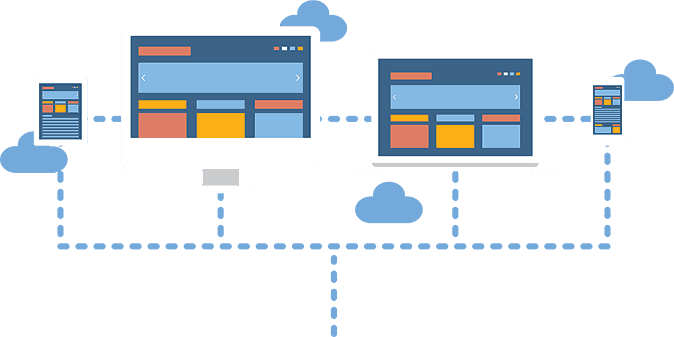
28 Sep What is Software Scalability and Why is it Important?
With the destabilizing effects of the pandemic last year, many organizations experienced the importance of software scalability firsthand. In this post we will look at what scalable software is, why it’s so important and how it works.
Defining Software Scalability
Software scalability is a measure of how easy it is to grow or shrink a piece of software. In many cases it refers to the software’s ability to handle increased workloads while adding users and removing them with minimal cost impact. Often software scalability also refers to the software’s ability to perform and support growing amounts of data.
Examples of Scaling Software
While software scalability is important to any business application, many Enterprise Resources Planning (ERP) solution providers differentiate themselves on scalability. This is because mission critical software like ERP that impacts compliance and other high-risk functions has traditionally been fairly rigid. Scaling software systems like this can be costly and time consuming.
A good example of user scalability is a seasonal business like retail that adds accounting temps during the holiday season to help with back office functions, and then let’s much of the staff go in mid January. Another example of software scalability is a growing business who’s accounting processes are growing exponentially. Being able to keep up with growth and contraction is what scalable software is all about.
Why Scaling Software is Important
Like we said above, for seasonal businesses, being able to scale up and down to meet seasonal demand changes is absolutely necessary. Plus, when software is too rigid, scaling can be costly. Now, here are two more reasons why software scalability is so important.
Performance and Data Security
Many entry-level accounting solutions like QuickBooks have set limits for some entry types. These may include a limit of 10,000 vendors, customers or payroll items. This is not very scalable. And more than that, functionality of the solution often deteriorates as business begins to approach these limits.
For mom-and-pop shops that plan to stay mom-and-pops, entry-level software is perfect. But for large companies and entrepreneurs with growth in mind, it’s a different story.
When entry-level software becomes overburdened it slows down, time-outs can become frequent and cause major headaches. These solutions also become more vulnerable to security threats as they age. Enterprises and small start-ups that plan to be big enterprises have to start out as a scalable, agile business so they can avoid these headaches in the future.
Seizing Opportunity
Zoom is a great example of this. There was some small “controversy” early on in the pandemic about how fast Zoom actually grew in early 2020, but it’s undeniable that they grew incredibly fast. They became the go-to video chat service in the U.S. during the technology’s biggest boom. While we want to be respectful of those who struggled or suffered as a result of the pandemic, one of the things Zoom did better than their competitors is scale their service offering and their business to support hundreds of thousands of users.
The point of the Zoom story is that scalability isn’t just about making room to grow, it’s about being able to seize opportunities when they come up. If your major business management systems aren’t scalable, you might miss critical opportunities. There is an interesting article on how Zoom scaled to meet the demand here.
Keys to Software Scalability
Software Selection and Infrastructure
As you can probably guess, hardware IT infrastructure is essential to software scalability to support larger databases and handle bigger workloads. It’s also important to select software for its scalability. For example:
-
How many users can you add?
-
Is it easy to add users?
-
How is it licensed (e.g. perpetual or subscription)?
-
What are its data limits?
-
What are its functionality limits?
-
Can functionality be expanded (e.g. app integrations)?
Integrations
The ability to integrate a variety of applications is key to expanding functionality of a piece of software. For example, a start-up company might begin with ERP and in their early days they are running their time & expense with the out-of-the-box functionality of the software. But as the business grows they may need more sophistication and automation to handle more employees. For these, the user company may integrate a purpose-built time & expense solution with the ERP to better support their rapidly growing staff.
Learn More: ERP Integration for More Powerful Apps
Cloud, SaaS and Hosting
It’s no secret that cloud computing has made software more agile. Cloud storage makes it easy to expand your datacenter. And these days, it’s pretty easy to get up and running on subscription based software or Software-as-a-Service (SaaS).
Cloud storage not only makes it possible to access data from anywhere, it makes it easier to store large amounts of data.
While SaaS software is used by nearly every business in the U.S. in some capacity, businesses may choose to purchase on-premise licenses for key solutions like financial software. Hosting these applications is a great option for this scenario. Businesses get the control of purchasing the software and the agility of cloud computing.
Learn More: What is a Hosted Application?
Conclusion
Software scalability is the ability to grow or shrink a piece of software to meet changing demands on a business. Software scalability is critical to support growth, but also to pivot during times of uncertainty and scale back operations as needed. Scaling software is a necessity for many seasonal industries. The keys to software scalability include hardware infrastructure, software selection and cloud accessibility.
Simplify Your Path to Secure Cloud
CyberlinkASP’s Virtual Desktop Hosting and Application Delivery Service provides secure, affordable, and scalable cloud hosting.
